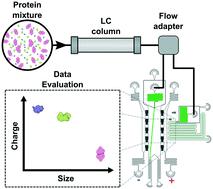Our official English website, www.x-mol.net, welcomes your
feedback! (Note: you will need to create a separate account there.)
Multidimensional protein characterisation using microfluidic post-column analysis.
Lab on a Chip ( IF 6.1 ) Pub Date : 2020-06-26 , DOI: 10.1039/d0lc00219d Tom Scheidt 1 , Tadas Kartanas , Quentin Peter , Matthias M Schneider , Kadi L Saar , Thomas Müller , Pavan Kumar Challa , Aviad Levin , Sean Devenish , Tuomas P J Knowles
Lab on a Chip ( IF 6.1 ) Pub Date : 2020-06-26 , DOI: 10.1039/d0lc00219d Tom Scheidt 1 , Tadas Kartanas , Quentin Peter , Matthias M Schneider , Kadi L Saar , Thomas Müller , Pavan Kumar Challa , Aviad Levin , Sean Devenish , Tuomas P J Knowles
Affiliation

|
The biological function of proteins is dictated by the formation of supra-molecular complexes that act as the basic machinery of the cell. As such, measuring the properties of protein species in heterogeneous mixtures is of key importance for understanding the molecular basis of biological function. Here, we describe the combination of analytical microfluidic tools with liquid chromatography for multidimensional characterisation of biomolecules in complex mixtures in the solution phase. Following chromatographic separation, a small fraction of the flow-through is distributed to multiple microfluidic devices for analysis. The microfluidic device developed here allows the simultaneous determination of the hydrodynamic radius, electrophoretic mobility, effective molecular charge and isoelectric point of isolated protein species. We demonstrate the operation principle of this approach with a mixture of three unlabelled model proteins varying in size and charge. We further extend the analytical potential of the presented approach by analysing a mixture of interacting streptavidin with biotinylated BSA and fluorophores, which form a mixture of stable complexes with diverse biophysical properties and stoichiometries. The presented microfluidic device positioned in-line with liquid chromatography presents an advanced tool for characterising multidimensional physical properties of proteins in biological samples to further understand the assembly/disassembly mechanism of proteins and the nature of complex mixtures.
中文翻译:

使用微流柱后分析进行多维蛋白质表征。
蛋白质的生物学功能由形成细胞基本机制的超分子复合物决定。因此,测量异质混合物中蛋白质种类的特性对于理解生物学功能的分子基础至关重要。在这里,我们描述了分析性微流体工具与液相色谱的结合,用于在溶液相中复杂混合物中生物分子的多维表征。色谱分离后,将一小部分流通物分配到多个微流体设备进行分析。这里开发的微流体装置可以同时测定分离的蛋白质种类的流体动力学半径,电泳迁移率,有效分子电荷和等电点。我们用大小和电荷不同的三种未标记模型蛋白的混合物证明了这种方法的操作原理。我们通过分析链霉亲和素与生物素化的BSA和荧光团的混合物,进一步扩展了提出的方法的分析潜力,它们形成了具有多种生物物理性质和化学计量比的稳定复合物的混合物。所提供的与液相色谱在线定位的微流体装置为表征生物样品中蛋白质的多维物理特性提供了一种先进的工具,以进一步了解蛋白质的组装/拆卸机理和复杂混合物的性质。我们通过分析链霉亲和素与生物素化的BSA和荧光团的混合物,进一步扩展了本研究方法的分析潜力,它们形成了具有多种生物物理特性和化学计量比的稳定复合物的混合物。所提供的与液相色谱在线定位的微流体装置为表征生物样品中蛋白质的多维物理特性提供了一种先进的工具,以进一步了解蛋白质的组装/拆卸机理和复杂混合物的性质。我们通过分析链霉亲和素与生物素化的BSA和荧光团的混合物,进一步扩展了本研究方法的分析潜力,它们形成了具有多种生物物理特性和化学计量比的稳定复合物的混合物。所提供的与液相色谱在线定位的微流体装置为表征生物样品中蛋白质的多维物理特性提供了一种先进的工具,以进一步了解蛋白质的组装/拆卸机理和复杂混合物的性质。
更新日期:2020-07-29
中文翻译:

使用微流柱后分析进行多维蛋白质表征。
蛋白质的生物学功能由形成细胞基本机制的超分子复合物决定。因此,测量异质混合物中蛋白质种类的特性对于理解生物学功能的分子基础至关重要。在这里,我们描述了分析性微流体工具与液相色谱的结合,用于在溶液相中复杂混合物中生物分子的多维表征。色谱分离后,将一小部分流通物分配到多个微流体设备进行分析。这里开发的微流体装置可以同时测定分离的蛋白质种类的流体动力学半径,电泳迁移率,有效分子电荷和等电点。我们用大小和电荷不同的三种未标记模型蛋白的混合物证明了这种方法的操作原理。我们通过分析链霉亲和素与生物素化的BSA和荧光团的混合物,进一步扩展了提出的方法的分析潜力,它们形成了具有多种生物物理性质和化学计量比的稳定复合物的混合物。所提供的与液相色谱在线定位的微流体装置为表征生物样品中蛋白质的多维物理特性提供了一种先进的工具,以进一步了解蛋白质的组装/拆卸机理和复杂混合物的性质。我们通过分析链霉亲和素与生物素化的BSA和荧光团的混合物,进一步扩展了本研究方法的分析潜力,它们形成了具有多种生物物理特性和化学计量比的稳定复合物的混合物。所提供的与液相色谱在线定位的微流体装置为表征生物样品中蛋白质的多维物理特性提供了一种先进的工具,以进一步了解蛋白质的组装/拆卸机理和复杂混合物的性质。我们通过分析链霉亲和素与生物素化的BSA和荧光团的混合物,进一步扩展了本研究方法的分析潜力,它们形成了具有多种生物物理特性和化学计量比的稳定复合物的混合物。所提供的与液相色谱在线定位的微流体装置为表征生物样品中蛋白质的多维物理特性提供了一种先进的工具,以进一步了解蛋白质的组装/拆卸机理和复杂混合物的性质。











































 京公网安备 11010802027423号
京公网安备 11010802027423号